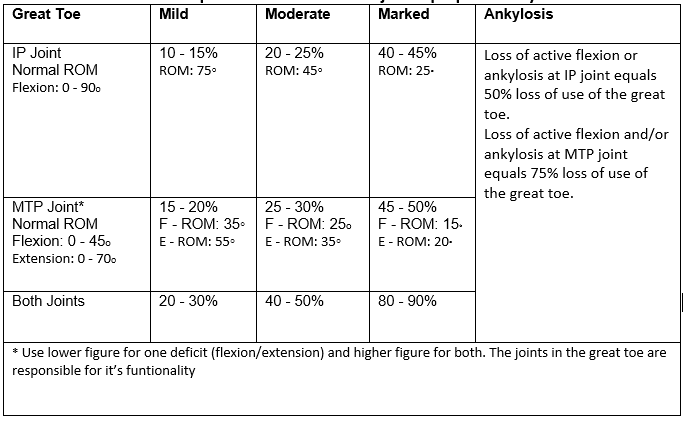Workers compensation Scheduled Loss
of Use for Great and Lesser Toes
If you’ve been injured at work and are wondering what “Scheduled Loss of Use” (SLU) means for your toes, you’ve come to the correct website! You may be eligible for a compensation payment that is determined by the Workers’ Compensation Board’s standards.
Our report will conclude that owing to your work-related accident, you have lost function in the injured body part that will last a lifetime. The Workers’ Compensation Guidelines for Assessing Injury are followed in our report. This article is based on New York state workers compensation rules.
Objectives for Determining Toe Impairment
The toes, especially the great toe, aid with posture and stability during everyday walking. Additionally, they offer assistance when attempting elevated reaching. An injury to more than one toe may be viewed as having an overall impact on the foot.
The objective is to precisely determine the physical deficit that the patient experienced as a result of their accident. The assessment should, to the greatest extent feasible, be based on factual information gleaned from the history and physical examination, as well as any relevant diagnostic test results.
Techniques for Determining Permanent Impairment
At the point of greatest medical improvement, when further healing is not anticipated, the degree of a permanent residual physical deficit is assessed by us. Based on the results of the clinical course of treatment, the medical provider’s experience, and any additional treatment alternatives accessible to the patient the maximum medical improvement should be assessed.
Where appropriate, the contralateral extremity and expected/normal values are taken into account by us when determining the degree of permanent residual physical deficit. The interval between an injury and the point of greatest medical progress can vary, although in most situations it is one year after the injury or the most recent surgery.
The mechanism of the damage has very little effect on how severe the permanent residual physical deficit is. In addition to physical injury to bone, muscles, cartilage, tendons, nerves, blood vessels, and other tissues, it can also reflect the permanent residual physical deficit at the point of maximum medical improvement.
Maximum Rating of Body Part
The great and lesser toes’ permanent residual physical deficit is to be assessed using these guidelines. The loss or impairment of a single toe must be assessed solely on the great or lesser toe and not on the entire foot.
The overall impairment cannot be greater than 100% of the next biggest major member when numerous toe impairments are taken into account in a single comprehensive rating. As a result, the loss of several toes that transforms into a foot disability is not allowed to surpass a % schedule loss of foot use.
The Big Toe
The great toe aids with unilateral stance and offers stability during everyday walking. When trying elevated reaching, the toe’s extension offers a lot of assistance. It has two principal joints:
- IP – Interphalangeal Joint;
The articulations between consecutive phalanges of the foot are called interphalangeal joints. Nine interphalangeal joints are present on each foot, two on each of the four lateral toes and one on the big toe. They are frequently characterized as:
- Proximal interphalangeal joints: located between the bases of the middle and proximal phalanges.
- Distal interphalangeal joints: those that exist between the bases of the distal phalanges and the heads of the middle phalanges.
Only one interphalangeal joint exists between the proximal and distal phalanges of the big toe because it lacks a middle phalanx. The middle and distal phalanges’ ability to flex and extend (plantarflexion and dorsiflexion, respectively) along one axis is made possible by the uniaxial hinge joints that make up the interphalangeal joints of the foot.
MTP – Metatarsophalangeal joint
The joints between the metatarsal bones of the foot and the proximal bones (proximal phalanges) of the toes are called metatarsophalangeal joints (MTP joints), which are also colloquially known as toe knuckles. Flexion, extension, abduction, adduction, and circumduction are all permissible movements in the metatarsophalangeal joints.

Great Toe
Calculating Loss of Use of Great Toe
Percent Loss of Use of Great Toe
Instructions: To the extent that there are deficits, select one from table below.
Maximum value cannot exceed ankylosis.
Schedule loss of use percentages for ranges of motion, values above/below
those depicted here should be adjusted proportionally

Smaller Toes (Second, Third, Fourth & Fifth)

Smaller Toes
Calculating Loss of Use of Smaller Toes
Smaller Toes
Percent Loss of Use of Smaller Toes
Instructions: To the extent there are deficits, add A + B + C.
Maximum value cannot exceed ankylosis
Schedule loss of use percentages for ranges of motion values above/below those depicted here should be adjusted proportionally

Percent Loss of Use of the Toe
Amputations, Ankylosis or Loss of Active Motion

Amputations and Loading
- Amputation of the great toe at the distal phalanx/distal interphalangeal joint results in a 50% loss of function.
- The great toe loses 50% of its function if a significant piece of the distal phalanx is amputated.
- Amputation of the great toe at the metatarsophalangeal joint or proximal phalanx results in complete loss of function.
- Foot schedules are loaded 50% and adapted for amputations of two or more toes.
- Each damaged toe carries 100% of the strain when there is bone loss through the metatarsals.
- The load is 25% when three or more toes are deficient without bone loss.
- Five metatarsal amputations are loaded to 100% and converted to a foot schedule.
Please refer to the Workers Compensation Board website of your state or speak with your Workers Compensation attorney for more information.
